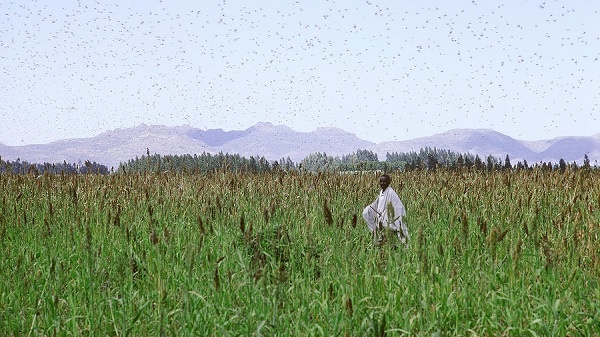
ADDIS ABABA (FAO) – Ethiopia’s Federal Ministry of Agriculture (MOA), Food and Agriculture Organization of the United Nations (FAO) and the Desert Locust Control Organization for Eastern Africa (DLCO–EA) have called for immediate action to control a new Desert Locust (Schistocerca gregaria) infestation in the country.
Sani Redi, Agriculture Sector State Minister, MOA called on development partners to support the government’s efforts to control the invasion.
“The desert locust invasion is likely to cause incalculable green vegetation loss,” he underscored. Although we have committed resources, we need substantial support to undertake massive control and preventive measures.”
Migrating from Yemen through Djibouti and Somaliland, Desert Locust swarms entered Ethiopia and settled in the breeding sites in Afar, Amhara, Oromia and Somalia regions. The swarms have produced hopper bands that have covered more than 174 square kilometer (in 56 Woredas and 1,085 kebeles) and are consuming approximately 8 700 metric tons of green vegetation every day. It is estimated that about 30 million hoppers can land on one-kilometer square area.
The moist soils due to the continued rainfall in the breeding sites created a conducive environment for Desert Locusts to multiply. Huge hopper populations are bred and are currently fledging into young adults and making swarms of varying sizes.
“The swarms are likely to invade wider areas and cause significant crop, pasture and forest cover losses in eastern Ethiopia,” warned Zebdewos Salato, Director of Plant Protection in the MoA.
To date, Desert Locust hopper bands have covered 17,370 out of the 28,671 hectares surveyed between July and September 2019.
Although the government is making efforts to contain the potential invasion of areas outside the breeding sites, its capacity to control the desert locust hopper bands in the breeding sites is limited. So far, it has controlled hopper bands on 6 455 hectares only.
The Desert Locust infestation happened this time when Ethiopia is dealing with the impacts of previous and ongoing drought. Currently other insect pests such as the fall armyworm and diseases such as wheat rusts are also serious impediments to agricultural production and food and nutrition security. The latest reports indicate that about 7.8 million people in the country require food assistance. This number is likely to increase if the fledgling Desert Locust swarms continue infesting more areas and causing damage to crops and natural vegetation.
“Urgent control operations are required to manage the situation and protect the livelihood of the population in eastern Ethiopia and possibly the neighboring countries,” said Fatouma Seid, FAO Representative in Ethiopia.
She added that FAO is working with the Ministry of the Agriculture, the DLCOEA and other stakeholders to undertake hopper control measures.
FAO operates a Desert Locust Information Service that receives and analyzes data from locust-prone countries to assess the current locust situation. It also provides forecasts and issues, warnings and alerts to keep the global community informed of locust developments and threats.
Dr Stephen W. Njoka, OGW, Director Desert Locust Control Organization for Eastern Africa (DLCO–EA) said the Organization was coordinating regional efforts, including monitoring, providing early warning and undertaking control actions to manage the invasion. He warned that the Desert Locust situation would turn 2019 into a disaster year unless it is curtailed. “We call for concerted efforts of all stakeholders to prevent a disaster from happening,” he said.
In July 2019, FAO warned that Desert Locust summer breeding, amplified by heavy rains, could pose a serious threat to agricultural production in Yemen, Sudan, Eritrea, parts of Ethiopia and northern Somalia. The Organization called on all countries to monitor the field conditions by mounting regular ground surveys and undertaking the necessary control measures whenever infestations were detected.
Source: FAO
